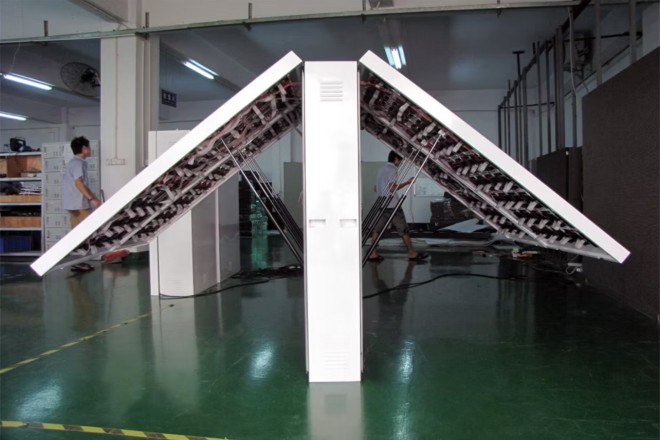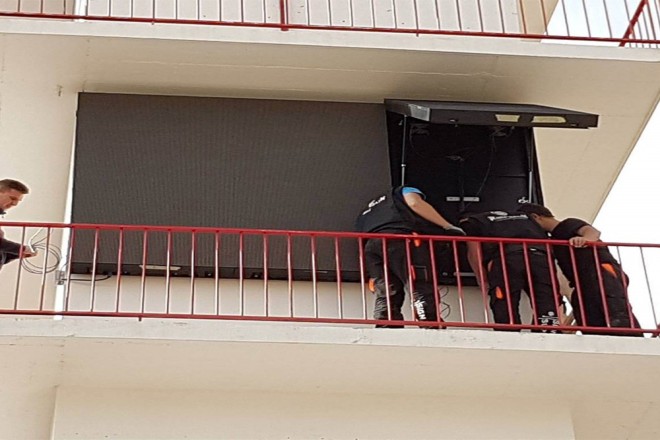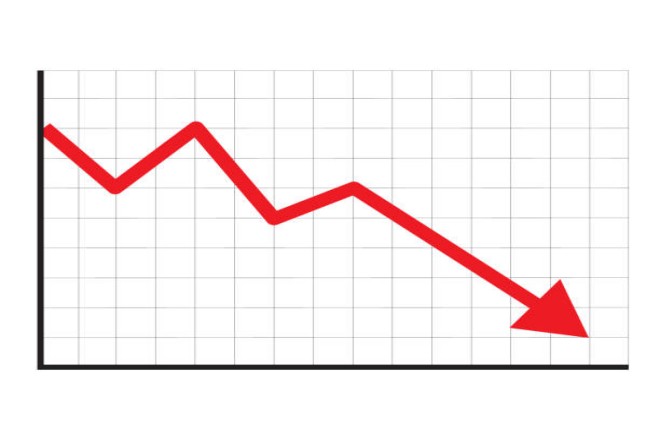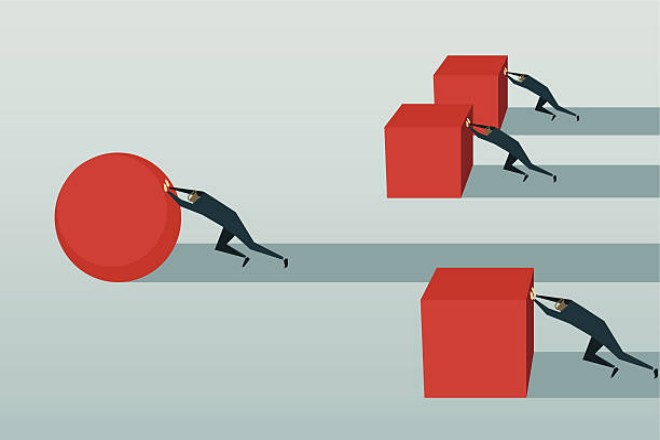مقدمة

As a very popular display screen on the market, there are many types of LED displays. But if you are careful, you will find that some LED displays are actually disappearing from the market.
على سبيل المثال، يعرض الصمام with front flip cover maintenance. So why are there fewer and fewer LED displays with front flip cover maintenance? This article will give you the answer.
1. What is a front maintenance LED display?
1). What does it look like?
Imagine that you have an LED display screen in front of you, just like the ones you often see in مراكز التسوق, concerts or cinemas. But this screen is a bit special. Its front panel is not fixed, but can be opened like a book. This is the front flip cover maintenance LED display screen!
Open this “lid” and you will find the “innards” of the display screen – circuit boards, LED lamp beads, and various connecting wires.
This design is super convenient, because once there is a problem with the screen, such as a lamp bead not lighting up, the technicians don’t have to go to the trouble of dismantling the entire screen, they can just open the lid to fix it.
If you still don’t understand, imagine your laptop, the screen can also be flipped open, right? The principle of the front flip cover to maintain the LED display is similar to this, except that it flips open the inside and the screen is outside; while the laptop flips open the screen.
2). How is it used? What are the advantages and disadvantages?
2.1). Advantages:
Quick fix: Is there a problem with the screen? Open the cover and replace the parts in a few minutes without waiting too long.
Save money and worry: Maintenance is simple, so the cost is low, and you don’t have to spend a lot of money to hire someone to repair it.
2.2). Disadvantages:
A bit heavy: Because there is an extra flip cover, the entire screen will be heavier than ordinary ones, and it will take some effort to install and carry it.
It may look a bit bulky: After all, not everyone likes the flip-cover mechanism. Some people may think it is not simple enough or beautiful enough.
More complicated structure: With the flip cover design, the structure inside is more complicated. If there is a problem with any small part, it may be a headache.
Reason 1: The impact of technological innovation on front maintenance?

1). Significant improvement in maintenance convenience
With the continuous advancement of LED display technology, the design of front-maintenance LED displays has become more and more perfect.
This design allows maintenance personnel to easily access and repair or replace faulty modules by simply unscrewing the front panel without disassembling the entire display. This change greatly simplifies the maintenance process, shortens maintenance time, and improves maintenance efficiency.
Imagine that in the past, if a display failed, maintenance personnel might have to spend a lot of time disassembling the entire display to find and fix the problem.
Now, they can directly locate and solve the problem by simply unscrewing the front panel, which undoubtedly greatly reduces the burden of maintenance work.
2). The power of design optimization
The new LED display design not only focuses on display effects and performance but also puts a lot of effort into maintainability. Designers began to pay more attention to the independence and replaceability of modules, ensuring that each module can work independently and can be easily replaced when a failure occurs.
This change in design thinking allows maintenance personnel to complete maintenance work without opening the entire display, further improving maintenance efficiency and reducing maintenance costs.
Moreover, this modular design also brings another benefit: when a module fails, it will not affect the normal operation of other modules, thus ensuring the overall stability and reliability of the display.
3). Innovation of materials and processes
The application of new materials and packaging technologies provides a strong guarantee for the stability and durability of LED display screens.
These materials not only have better heat resistance and corrosion resistance but also effectively resist interference from the external environment, thereby greatly reducing the probability of failure.
At the same time, more advanced processing technology makes the display screen modules more compact and reliable, further reducing maintenance requirements.
The advancement of these materials and processes enables LED display screens to maintain stable performance under long-term and high-intensity use, reducing downtime caused by failures and improving the availability and reliability of the display screen.
4). Profound changes in maintenance methods
With the continuous innovation of technology, the maintenance methods of LED display screens have also undergone earth-shaking changes.
Some manufacturers have begun to adopt a rear maintenance method, allowing maintenance personnel to perform maintenance operations from the back of the display screen without opening the front flip cover.
This transformation not only improves maintenance efficiency but also makes the appearance design of the display screen more concise and beautiful.
Moreover, the introduction of intelligent monitoring and remote maintenance technology has pushed the maintenance method of LED display screens to a new level. Through the Internet of
Things technology and intelligent diagnostic systems, maintenance personnel can monitor the working status of the display screen in real-time and promptly discover and deal with potential problems. Fault diagnosis and repair can be performed remotely, greatly reducing the reliance on front flap maintenance.
Reason 2: Changes in market demand and consumer preferences

With the rapid development of LED display technology, its application scenarios are becoming increasingly rich, and consumer demand is also constantly upgrading.
These changes are quietly driving a profound change in the maintenance method of LED display screens. Below, we will discuss this change in detail through specific examples.
1). Diversification of application scenarios:
- Traditional applications:
Imagine that on the busy streets of the city, huge LED billboards attract the attention of pedestrians. These billboards mostly use a front flap design to facilitate the quick replacement of advertising content.
However, when these displays are installed on the top of high-rise buildings or embedded between narrow walls, front flap maintenance becomes very inconvenient, not only difficult to operate but also may bring safety hazards.
- Emerging fields:
With the rise of virtual reality (VR) and augmented reality (AR) technologies, LED screens have begun to shine in virtual shooting and immersive experience halls.
In these scenes, the screens are often designed with complex curves or super-large sizes, and the front flap maintenance obviously cannot meet the needs of such high customization and flexibility.
For example, during the filming of the movie “Avatar,” a large number of LED screens were used to build a virtual environment. These screens need to be frequently adjusted and maintained, and the front flap design obviously cannot meet this requirement.
2). Changes in maintenance costs:
- اعتبارات التكلفة:
Although the front flap maintenance seems convenient in the short term, its maintenance cost may quietly rise in long-term use. For example, in large shopping malls, many LED screens need to be regularly inspected and replaced.
The front flap design may require more maintenance personnel and a longer time to complete this task, thereby increasing manpower and time costs.
- فوائد طويلة الاجل:
In contrast, LED screens with rear maintenance design, such as cleverly hiding the maintenance interface on the back of the screen, not only reduce the front space occupation, improve the aesthetics, but also greatly reduce long-term maintenance costs.
For example, in high-end retail stores, exquisite LED screens are an important part of product display, and the rear maintenance design allows store staff to easily complete maintenance work without affecting the customer’s shopping experience.
3). Changes in consumer preferences:
- Aesthetic pursuit:
Nowadays, consumers not only pay attention to the functionality of LED screens but also pay more attention to their appearance design. The front flap maintenance method often requires a large maintenance space to be reserved, which is particularly abrupt in high-end commercial displays or art installations.
For example, in the art المعارض of المتاحف, the LED screen is part of the exhibits, and its appearance must be coordinated with the overall style of the exhibits. The front flap design obviously makes it difficult to meet this aesthetic requirement.
- Intelligent needs:
In the digital age, consumers are increasingly inclined to choose intelligent and convenient products. Although the front flap maintenance method is simple and intuitive, it seems to be unable to do so in terms of intelligent maintenance.
In contrast, new maintenance methods with remote monitoring and intelligent diagnosis functions can better meet the needs of consumers. For example, in smart homes, LED screens are part of the home entertainment system.
Users can remotely monitor their working status through mobile phone APPs, discover and solve problems in a timely manner, and greatly improve the convenience and comfort of use.
4). The rise of new maintenance methods:
- The popularity of rear maintenance design:
In view of the limitations of the front cover maintenance method, more and more manufacturers have begun to adopt the rear maintenance design. This design not only improves maintenance efficiency but also improves the aesthetics and flexibility of the display.
For example, in large-scale concerts or sports events, LED displays need to be frequently moved and adjusted, and the rear maintenance design makes this process smoother and more efficient.
Reason 3: Industry competition and industrial upgrading

1). Industry competition:
- The “arms race” of technological innovation
In the LED display industry, technological innovation is like an endless “arms race.” Companies have shown their “killer mace” and strive to be one step ahead in technology.
Front cover maintenance, which was once regarded as a convenient maintenance method, seems a bit “incapable” in the face of new technologies.
New maintenance technologies, such as remote monitoring and intelligent diagnosis, not only improve maintenance efficiency but also greatly reduce maintenance costs, making front cover maintenance seem a bit “outdated.”
- The “picky” and “variable” needs of customers
Today’s customers are really “picky” and “variable.” They not only require the LED display to be powerful but also beautiful and easy to maintain.
Although front cover maintenance is simple, it often requires a large space to be reserved, which is obviously a big “flaw” in today’s pursuit of extreme beauty and space utilization.
What customers want to see more is a maintenance method that is both beautiful and practical, such as the rear maintenance design, which saves space and improves the convenience of maintenance.
- Brand image “shaping war.”
In the market competition, brand image is the “golden signboard” of the company. A good brand image can not only attract customers but also enhance the competitiveness of the company.
However, due to its limitations and inconvenience, the front cover maintenance may give customers a “negative impression” of the company’s brand image. In order to create a better brand image, companies naturally have to choose more advanced and efficient maintenance methods.
2). Industrial upgrading:
- The “wave” of production automation and intelligence
With the advancement of science and technology, the production of LED displays is moving towards automation and intelligence. Robots and intelligent equipment have been “put into work” one after another, greatly improving production efficiency and product quality.
The front cover maintenance, a maintenance method that relies on manual operation, obviously cannot keep up with this “intelligent wave”. Enterprises are more inclined to adopt smarter and more efficient maintenance methods to meet the needs of industrial upgrading.
- The “big picture” of industrial chain integration and optimization
In the context of industrial upgrading, industrial chain integration and optimization have become a general trend. Enterprises are seeking to integrate upstream and downstream resources to reduce production costs, improve product quality and service levels.
However, the front cover maintenance, due to its high maintenance cost and complex operation, is obviously not in line with the “big picture” of industrial chain integration and optimization. Enterprises are more inclined to choose a more economical and efficient maintenance method.
خاتمة
In short, the reduction of front cover maintenance LED display screens is the inevitable result of the dual-wheel drive of technological progress and market demand. On the one hand, the emergence of new technologies has reduced the complexity of maintenance and improved the overall performance of the display screen.
On the other hand, the market’s pursuit of more efficient, more beautiful, and more flexible products has prompted the industry to continue to innovate, and the front cover design has gradually become out of date. Although front cover maintenance still has its unique value in specific areas, the overall trend is irreversible.
أخيرًا، إذا كنت تريد معرفة المزيد عن شاشات LED، يرجى الحصول على اتصال معنا.
